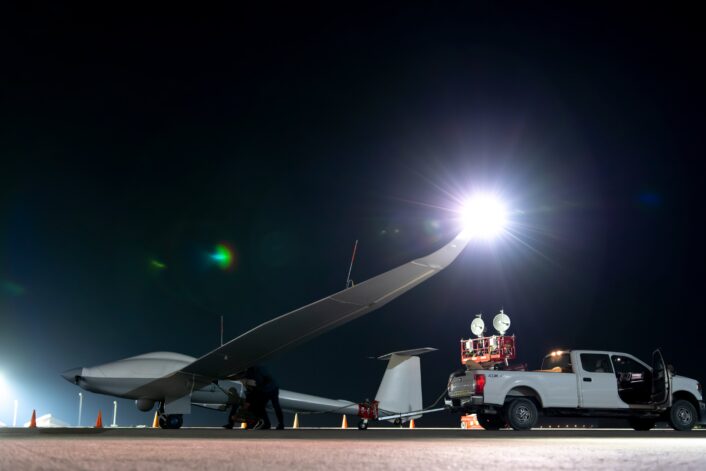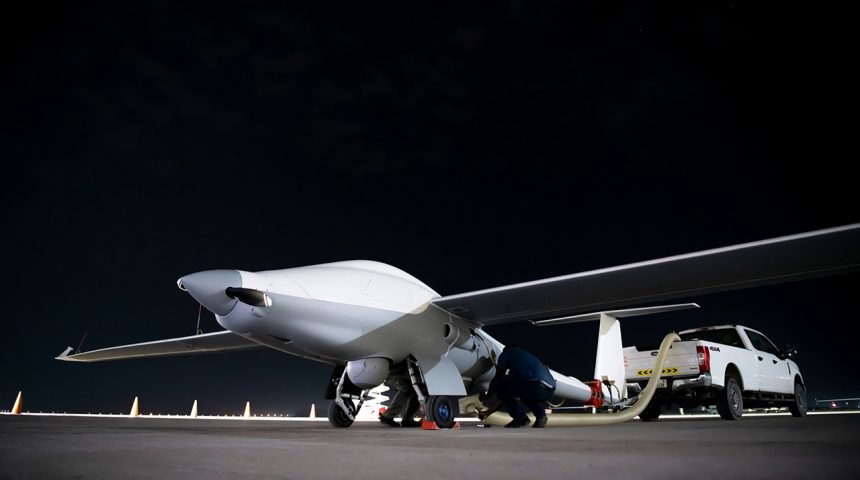The ULTRA can fly for days on end with continuous eyes on the surface, allowing Air Force planners massive tactical flexibility.
The U.S. Air Force’s ULTRA (Unmanned Long-Endurance Tactical Reconnaissance Aircraft) made a rare appearance at an “undisclosed location” in the Middle East suggesting that the platform has been operationally deployed for the first time.
A series of images were published on the US DoD DVIDS network, showing the preparation of the unmanned glider aircraft for a mission.
US Air Force Unmanned Long-Endurance Tactical Reconnaissance Aircraft crew chiefs prep an ULTRA for taxi before takeoff at an undisclosed location within Central Command area of responsibility on May 7. ULTRA is an unmanned aerial system capable of flight times up to 80 hours. pic.twitter.com/qz9U6taBqM
— Ryan Chan 陳家翹 (@ryankakiuchan) May 8, 2024
The drone’s design is based on a manned sports glider that was reoriented for a long-duration surveillance role.
The platform is one-of-a-kind, given its interesting techno-industrial development history and optimum performance capabilities for its intended role. The purely reconnaissance and surveillance platform, capable of staying in the air for nearly 80 hours, was rapidly developed in under a year to meet today’s warfare’s two simple needs.
One is the need for simple, industrially scalable platforms that can rapidly be manufactured in case of attrition and heavy losses. Second, is the primacy of enhanced situational awareness, where maximum possession of battlefield information, sometimes across a theater, has been assessed to be more decisive than core combat power. As will be explained subsequently, the ULTRA’s simple components and high-endurance that can last for days satisfy both criteria.
ULTRA Operationally Deployed?
The images released by the U.S. Air Force suggest that the ULTRA has been operationally deployed or possibly has been for a while.
Interestingly, the photos have now been removed from the DVIDS website, possibly for security concerns following the identification of the “undisclosed location”.
The ‘undisclosed location’ is Al Dhafra Air Base in the UAE. The ULTRA drone can be seen in one of the photos occupying hangar 5 which was used to house global hawks in the past. https://t.co/MrAs3qvnO2 pic.twitter.com/BOgORmaXUc
— IntelWalrus (@IntelWalrus) May 8, 2024
Previous coverage in official releases dates back to December 2019, when the drone was being tested.
At the time, the AFRL (Air Force Research Laboratory) was publicizing the ULTRA’s initial flight test from the Wright-Patterson Air Force Base in Ohio. The drone was designated the Ultra LEAP (Long-Range Endurance Aircraft Platform) at the time. The UAV flew a “two and a half-day continuous flight demonstration from December 9 to December 11” during the test.
Cheap, Simple, Mass Manufactured Permanent ‘Eye in the Sky’
The statement described the ULTRA as an “affordable, high-performance, cost-effective sports-class commercial airframe converted to a fully automated system with autonomous takeoff and landing capabilities.” The high level of automation reduces “operator training requirements,” with “smaller support crews also (leading) to lower operating costs.”
It was developed from “concept to first flight” in “less than 10 months,” with the report adding that the system could be “ready for operational fielding as soon as 2020.” The AFRL said it achieved these industrial features through “commercial, off-the-shelf UAS technology, existing manufacturing and supply channels, and limited custom avionics.” These features keep “acquisition” and maintenance “costs low.”

Integration of lower cost Electro-Optical/Infra-Red (EO-IR) and Radio Frequency (RF) sensors is made possible due to lower operating altitudes which, “don’t require large optics, or high-power RF to maintain effectiveness.” ULTRA relies on an operator-friendly command and control system that allows for “Point and Click” operations. Full global operations are possible through satellite-based command and control links that also provide the high-rate ISR data feed to the operators in real time.
Today’s Wars Uphold the ULTRA’s Concept
These requirements have been validated by the war in Ukraine and the emerging flashpoint in Asia-Pacific – the latter where China is itself learning lessons from Moscow and Kyiv’s successes and failures. Russia and Ukraine have been using simple, off-the-shelf, commercially available roles for everything from elementary tactical battlefield reconnaissance and artillery fire correction to even kamikaze attacks. This is achieved by strapping civilian quadcopter UAVs with explosives and flying them into enemy armor, bunkers, and even individual soldiers.
For surveillance, both Russia and the US use MALE/HALE (Medium/High-Altitude Long-Endurance) drones like the MQ-9 Predator, the MQ-4 Global Hawk, or the Sirius UCAV. But replacing the multi-million dollar platforms becomes an expensive affair. Moreover, their loss would also represent a disadvantageous cost-to-benefit ratio, especially when shot down by simple anti-air missiles costing less than a million dollars.
The American drones patrol the Black Sea well outside Russian airspace, reportedly providing optical and electronic surveillance data to Ukrainian cruise and naval kamikaze drone boat strikes.
In theory, the party capable of fusing and analyzing data from various streams for greater situational knowledge of the battlespace can win at the strategic level, even while taking tactical losses.
The US’s F-35 and China’s J-20 are the tactical embodiment of this doctrine, often viewed as flying tactical command posts, lending and coordinating the intelligence they sweep up with other platforms. But again, a shootdown of these aircraft will entail a deep monetary toll, even for an industrially advanced nation like China, that can churn out more stealth fighters than the US can produce F-35s or F-22s.
For an intelligence-surveillance-reconnaissance (ISR) drone, staying in the air for days on end with continuous eyes on the surface allows Air Force planners massive tactical flexibility. While it can be shot down, the air defense missile reveals its position too. Information on that can be transmitted to friendly-assets via a “high-rate ISR data relay link.” The evolution of the ULTRA UAV should be seen amid this emerging military thinking.









